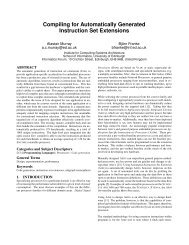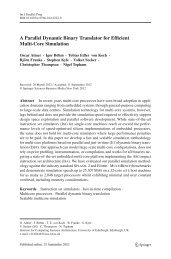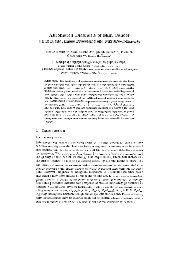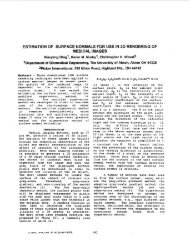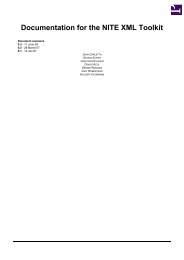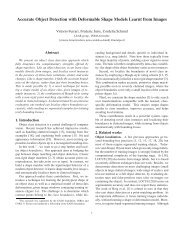WebExp2 Experimenter's Manual - School of Informatics - University ...
WebExp2 Experimenter's Manual - School of Informatics - University ...
WebExp2 Experimenter's Manual - School of Informatics - University ...
Create successful ePaper yourself
Turn your PDF publications into a flip-book with our unique Google optimized e-Paper software.
Figure 22: HTML to include the experimental applet in a web page.<br />
<br />
<br />
<br />
<br />
<br />
<br />
<br />
Sorry, your browser is not Java enabled.<br />
<br />
6.4.2 Javascript and the browser<br />
The section <strong>of</strong> the applet tag definition between tags may appear confusing. This is a bit <strong>of</strong> javascript<br />
which will write another tag into the HTML, describing which browser the participant is using.<br />
The most reliable way <strong>of</strong> finding out what type <strong>of</strong> browser the participant is using is by querying the browser<br />
itself with javascript; it cannot be done in Java. This bit <strong>of</strong> code does that and writes the result to the HTML<br />
page so you get something like . The actual value is far more<br />
lengthy, but you can usually ascertain the source browser from the name near the end <strong>of</strong> the value, or failing<br />
that the generic name near the start.<br />
Therefore you don’t need to worry about this code or how it works, just include it if you want to know what<br />
browser is being used to view your experiment. The value is added to the results and recorded in the subject<br />
results file.<br />
6.4.3 Applet attributes and parameters<br />
When you include the tag in your webpage, there are two groups <strong>of</strong> settings to configure. Firstly there<br />
are the attributes <strong>of</strong> the applet, which are defined in the opening tag; these are properties which relate directly<br />
to the applet. Secondly there is the set <strong>of</strong> parameters, which define properties which the <strong>WebExp2</strong> client itself<br />
can read and use.<br />
Applet attributes The attributes define basic features <strong>of</strong> the applet. They are <strong>of</strong> the form attribute=”value”<br />
and are specified in the opening tag.<br />
To centre an applet horizontally in the page, surround the element with tags.<br />
The codebase attribute is only necessary if the root release directory (with the jar file and data) is different<br />
from the directory containing the webpage. If your webpages are hosted outside <strong>of</strong> the release directory, then<br />
you should specify the codebase attribute. For this reason, it is easiest when testing your experiments to place<br />
their supporting HTML pages in the release directory and run them from there, so the codebase tag does<br />
not need to be defined. Note that the webpages may be hosted separately from <strong>WebExp2</strong>, in which case the<br />
codebase should specify the full path <strong>of</strong> the server and directory containing <strong>WebExp2</strong>.<br />
43



